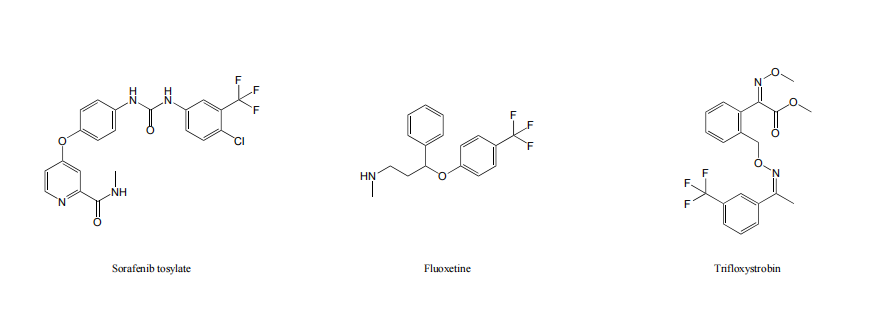Trifluoromethyl in organic synthesis
Introduction
Trifluoromethyl is one of the important chemical groups in the field of medicinal chemistry, and is widely used in bioactive molecules because of its high lipid solubility, excellent metabolic stability, high electronegativity and good bioavailability. The introduction of trifluoromethyl in drug molecules is due to its strong electron absorption induction effect, lipophilicity and stable C-F bond, which can effectively prolong its action time in the organism and enhance its metabolic stability; at the same time, the introduction of trifluoromethyl will also increase the lipid solubility of drug molecules, thus helping the absorption, delivery and diffusion of drug molecules in the organism.

Figure 1. Drug molecules containing trifluoromethyl
1. Anti-cancer drug--Sorafenib tosylate
2. Antidepressant drug--Fluoxetine
3. New plant broad-spectrum fungicide – Trifloxystrobin
Since fluorine-containing compounds are relatively rare in nature, it is an important research direction in chemistry today to introduce fluorine-containing groups into various organic compounds to prepare special fluorine-containing compounds in a convenient, mild, efficient and safe way.
The introduction of trifluoromethyl groups is generally divided into two categories:
Ⅰ. Direct fluorination:
Trimethyl(trifluoromethyl)silane(TMSCF3)?is one of the most widely used reagents for nucleophilic trifluoromethylation. It is also known as Ruppert-Prakash reagent since Ruppert introduced it in 19841?and Prakash was later largely responsible for promoting its use2.The wide applicability of TMSCF3 has made it a common reagent for the synthesis of various drug targets.
?
During the synthesis of glutamate and glutamine peptides with a trifluoromethyl ketone moiety3, β-amino alcohols are synthesized in five steps, the key step of which is the generation of a single diastereomeric trifluoromethylmethylsilyl ether using TMSCF3?(Scheme 1). The two reported peptides showed inhibitory activity against severe acute respiratory syndrome coronavirus protease (SARS-CoV 3CLpro).
Scheme 1
Another example is the synthesis of a non-steroidal selective androgen receptor modulator using TMSCF3, which exhibited excellent oral bioavailability and anabolic activity in muscle (Scheme 2) 4. This compound also improved bone strength in a rat model of postmenopausal osteoporosis. Similarly, Hudso and his colleagues synthesized another selective glucocorticoid receptor modulator using TMSCF3?that showed the same antiproliferative activity as the myeloma therapeutic agent dexamethasone (Scheme 3) 5.
Scheme 2

Scheme 3
Usually, additional fluoride sources (TBAF, CsF, etc.) are required to initiate the trifluoromethylation reaction. However, a recent report by Prakash details the use of a series of catalysts that do not require additional fluoride initiators or anhydrous conditions for the trifluoromethylation of carbonyl compounds (Scheme 4) 6.
Another report by Prakash showed that the treatment of N-unactivated imines using TMSCF3?gave the corresponding trifluoromethylamines. Difluoromethylamines can also be prepared by HF elimination and reduction with a slight change in reaction conditions (Scheme 5) 7.
Scheme 5
Although Ruppert-Prakash reagent is widely used, stereoselective trifluoromethylation using this reagent is still a challenge. dieter Enders reported diastereoselective trifluoromethylation of α-alkyldioxane with very good yields and high diastereo- and enantiomeric excesses?8. The acetone moiety was easily removed to produce 2-trifluoromethyl-1,2,3-triol (Scheme 6).
Scheme 6
Shibata and Toru's team recently reported an operationally simple method for enantioselective trifluoromethylation based on a combination of ammonium bromide (1) and tetramethylammonium fluoride (TMAF) of cinchona alkaloids. The reaction proceeded in moderate to excellent yields with ee ’s up to 93% (Scheme 7).
Ⅱ.?Trifluoromethyl?building?blocks
The most classic trifluoromethyl building block is ethyl trifluoroacetoacetate, which is one of the most important building blocks in the synthesis of fluorinated heterocyclic compounds. Because of its multiple reaction sites and ketone and enol properties, it can be used in different reactions to construct fluorinated indoles, pyrazoles, pyrimidines and other fluorinated heterocycles, and is used in the synthesis of fluorinated intermediates for pharmaceutical, pesticide, dye and other applications 9,10.

Figure 2. some important trifluoromethyl heterocycles
Ethyl trifluoroacetoacetate, cyanoacetamide and aryl aldehydes were used as raw materials for the synthesis of 3-arylamino-4-aryl-6-trifluoromethylpiperidin-2-one compounds under piperidine catalysis. After Hofmann rearrangement and aryl migration, the compound was reacted with iodobenzene acetate under basic conditions to finally produce 3-aryl-6-trifluoromethylpyridin-2-one compound.

Scheme 8. Ethyl trifluoroacetoacetate as fluorinated building blocks
These fluorinated building blocks were developed in Japan by the group of Kenji Uneyama 11?in 1992. The use of trifluoroacetic acid and amine in the presence of carbon tetrahalide and triphenylphosphine led to the synthesis of a series of fluorinated imide acyl halide compounds.
Since then, Hao jian's group synthesized 2-fluoroalkyl-substituted benzo 1,3 diazoles in one pot under the reaction conditions of triethylamine, carbon tetrachloride and triphenylphosphine, fluorinated carbonic acid and o-amino, hydroxy or mercapto substituted aniline and based on this, more substrates and derivatives were used in an attempt to synthesize more compounds with potential biological activity 12.
References:
1.Ruppert?I,?Schlich?K,?Volbach?W.?1984.?Die ersten CF3-substituierten organyl(chlor)silane.?Tetrahedron Letters.?25(21):2195-2198.?https://doi.org/10.1016/s0040-4039(01)80208-2
2.Prakash?GKS,?Krishnamurti?R,?Olah?GA.?1989.?Synthetic methods and reactions. 141. Fluoride-induced trifluoromethylation of carbonyl compounds with trifluoromethyltrimethylsilane (TMS-CF3). A trifluoromethide equivalent.?J. Am. Chem. Soc..?111(1):393-395.?https://doi.org/10.1021/ja00183a073
3.Sydnes?MO,?Hayashi?Y,?Sharma?VK,?Hamada?T,?Bacha?U,?Barrila?J,?Freire?E,?Kiso?Y.?2006.?Synthesis of glutamic acid and glutamine peptides possessing a trifluoromethyl ketone group as SARS-CoV 3CL protease inhibitors.?Tetrahedron.?62(36):8601-8609.?https://doi.org/10.1016/j.tet.2006.06.052
4.Martinborough?E,?Shen?Y,?van Oeveren?A,?Long?YO,?Lau?TLS,?Marschke?KB,?Chang?WY,?López?FJ,?Vajda?EG,?Rix?PJ,?et al.?2007.?Substituted 6-(1-Pyrrolidine)quinolin-2(1H)-ones as Novel Selective Androgen Receptor Modulators.?J. Med. Chem..?50(21):5049-5052.?https://doi.org/10.1021/jm070231h
5.Hudson?AR,?Roach?SL,?Higuchi?RI,?Phillips?DP,?Bissonnette?RP,?Lamph?WW,?Yen?J,?Li?Y,?Adams?ME,?Valdez?LJ,?et al.?2007.?Synthesis and Characterization of Nonsteroidal Glucocorticoid Receptor Modulators for Multiple Myeloma.?J. Med. Chem..?50(19):4699-4709.?https://doi.org/10.1021/jm070370z
6.Prakash?GKS,?Panja?C,?Vaghoo?H,?Surampudi?V,?Kultyshev?R,?Mandal?M,?Rasul?G,?Mathew?T,?Olah?GA.?2006.?Facile Synthesis of TMS-Protected Trifluoromethylated Alcohols Using Trifluoromethyltrimethylsilane (TMSCF3) and Various Nucleophilic Catalysts in DMF.?J. Org. Chem..?71(18):6806-6813.?https://doi.org/10.1021/jo060835d
7.Prakash?GKS,?Mogi?R,?Olah?GA.?2006.?Preparation of Tri- and Difluoromethylated Amines from Aldimines Using (Trifluoromethyl)trimethylsilane.?Org. Lett..?8(16):3589-3592.?https://doi.org/10.1021/ol061357w
8.Enders?D,?Herriger?C.?2007.?Asymmetric Synthesis of 2-Trifluoromethyl-1,2,3-triols.?Eur. J. Org. Chem..?2007(7):1085-1090.?https://doi.org/10.1002/ejoc.200600895
9. Zhu Shizheng, Wang Yanli, Jin Guifang. Research on fluorine-containing active methylene compounds [J]. Journal of Chemistry, 2002 (04): 555-565+758
10. Zhao Min, Yang Xiangmin. Synthesis of a new class of trifluoromethyl ketones [J]. Journal of East China University of Technology, 1999 (04): 111-112
11. Tamura, K.; Mizukami, H.; Maeda, K.; Watanabe, H.; Uneyama, K., J. Org. Chem.1993,58, 32.
12. Ge, F.; Wang, Z.; Wan, W.; Lu, W.; Hao, J., Tetrahedron Lett.2007,48, 3251.
 首页
首页 400-620-6333
400-620-6333




 危险品化学品经营许可证(带存储)
危险品化学品经营许可证(带存储)